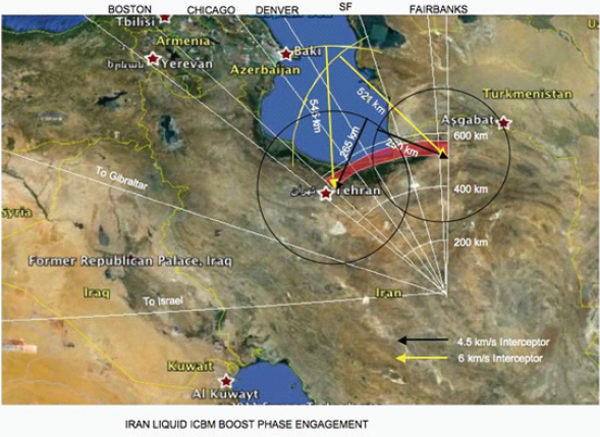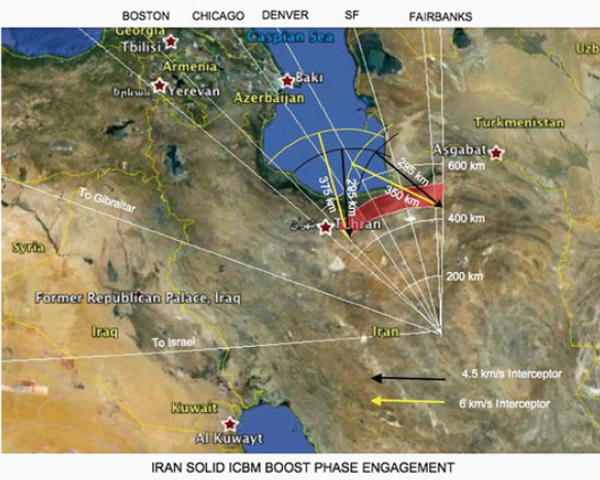BACKGROUND
One of the primary perceived benefits of boost-phase defense is the ability to shoot down a missile during its powered phase, when it presents a bright plume signature and before it disperses its payload and countermeasures, thereby clearly identifying the target to be destroyed. This potential to overcome the midcourse discrimination problem has been among the reasons for interest in the pursuit of boost-phase defense.
The difficulty is that the boost-phase interceptor (BPI) has to be within range of a point at which it can intercept the target when launch occurs and must be able to respond with a very short action time. This turns out to be much easier said than done. Since the time from detection of a hostile launch until it completes boost is often as little as a minute and, even for slower burning liquid-fueled intercontinental ballistic missiles (ICBMs) is unlikely to exceed 250 sec, any boost-phase intercept—accomplished kinetically or by directed energy—must be launched after detection from a platform that is within the range and action time of the interceptor, essentially intercepting before “booster cut-off” of the hostile missile.
While it sounds like a good idea, boost-phase defense presents a unique set of challenges. For starters, whether a solid or liquid rocket motor is used to propel the hostile missile, the boost-phase timeline is very short. In a gross sense, the intercept process must first determine if the launch in fact is a hostile missile and, if it is, determine its trajectory. Then the vehicle providing the “kill” function—known as the kill vehicle (KV)—must acquire and shoot at the target. Here, detection range and kill range capability must be considered.
Ground- and ship-based, manned and unmanned aircraft as well as space-
based interceptor platforms have all been proposed, but either the interceptor platform has to be so close to the threat launch point as to be vulnerable to attack itself, or the velocity of the intercepting projectile has to be very great. The latter is one reason for the interest in using directed-energy (speed of light) weapons for boost-phase interecept.
Today’s proposed boost-phase systems originated in the Strategic Defense Initiative era’s research programs. In more recent years, considerable effort has been expended in the development of an in-flight directed-energy platform—a heavily modified Boeing 747-400F airplane. Another option is destroying missiles on their launch pads prior to a suspected launch; this could have grave political consequences should an “innocent” missile be destroyed on the pad.
While boost-phase defense has been advocated as the most efficient way to deal with fractionated payloads and exoatmospheric (midcourse) penetration aids, it is extremely sensitive to assumptions about threat booster characteristics. Over time, boost-phase defense tends to be renamed ascent-phase defense when the kinematic realities set in. In fact, ascent-phase defense is code for engagement in the postboost or early midcourse phases of flight.
The limitations and complications of a surface-based boost-phase defense lie primarily in the concepts of operations (CONOPS), policy, time, and geography. Since the timelines for engagement in the boost-phase are extremely short, the on-site commander must have authorization from the National Command Authority to launch an interceptor immediately after a threat missile has been detected.1 Also, access must be gained to countries adjacent to the threat country in order to position a boost-phase system close enough, and at the correct geometries, to successfully engage the threat missile. Finally, boost-phase systems are only effective against countries that do not have large enough landmasses to allow them to launch missiles from deep within their territory.
The airborne laser is designed to deliver energy at the speed of light to perform the boost-phase intercept mission. Space-based lasers were also pursued in the past. Virtually no fly-out time is involved, and the beam agility is a function only of how fast the pointing optics can be repositioned. While laser weapons sound like the obvious answer, the energy that a laser can deliver on a target is limited by the power available and the aperture of the device. Atmospheric effects disturb the beam. Much has been accomplished in advancing the pointing and tracking capabilities and the adaptive optics to maintain beam quality, but some fundamental limitations remain.
_____________
1Even if the weapons release delay is assumed to be zero, the range limits make boost-phase defense infeasible.
PROPOSED SYSTEMS
The recently redirected airborne laser (ABL) program was one of two boost-phase systems under development. While the ABL program came from more than 2 decades of military laser development, it could not provide an operationally useful boost-phase capability, partly because the inherent range limitations of the atmospheric propagation meant that the Boeing 747-400F would need to operate in hostile airspace. An alternative approach has been to develop a kinetic kill vehicle (KKV) for boost-phase defense by harnessing the successful investments the United States has made over the past several decades for the purpose of midcourse defense, although a KKV for this purpose would have to be much more agile than a KKV for midcourse defense. The Kinetic Energy Interceptor (KEI) program was undertaken for that reason. In principle, boost-phase kinetic interceptors could be launched from land-, sea-, air-, or space-based platforms. However, the efficacy of such interceptors is uncertain. In the following section the committee provides additional information on the U.S. boost-phase systems examined in this report, as called for in the congressional tasking. Specifically, the KEI and ABL programs and other existing boost-phase technology demonstration programs are first described and then analyzed.
Kinetic Energy Interceptor
The KEI program was initiated in 2002 by the Missile Defense Agency (MDA) based on a recommendation by the Defense Science Board that a boost-phase intercept capability be developed with higher average velocity (high vbo and high acceleration) missiles to enhance ballistic missile defense and as an alternative to the ABL program.2 The Office of the Under Secretary of Defense for Policy also found that a boost-phase intercept capability was required for affordability reasons. Furthermore, the ABM Treaty had recently been abrogated, making it possible to develop and deploy such a system. MDA developed a capabilities-based Request for Proposal for a transportable, ground-based boost-phase interceptor system and presented it to industry in December 2002.
The KEI program was originally funded as a $4.6 billion (in then-year dollars), 8-year development and test boost-phase system using a modified SM-3 seeker and an Exoatmospheric Kill Vehicle Divert and Attitude Control System (EKV DACS) for the KV. Immediately after the contract had been awarded, however, the funding for KEI was significantly reduced and government requirements were added. The mission was expanded in 2004 to include not only boost-phase intercepts but also ascent-phase (prior to countermeasure deployment) and midcourse intercepts.
The KEI program was terminated in 2009, just before a planned booster
_____________
2Sean Collins, Missile Defense Agency, “Kinetic Energy Interceptor (KEI) Briefing to the National Academy of Sciences,” presentation to the committee, January 14, 2010.
flight test. According to MDA, the threat had evolved to the point where the expected capability of the KEI system was inconsistent with the strategy for countering rogue nation threats.3 It is also possible that extremely high costs and delays played a role in termination of the program. By that time, the KEI program had experienced mission changes coupled with technical difficulties, which led to cost growth. The projected cost to complete the contract almost doubled, from $4.6 billion to $8.9 billion (also in then-year dollars). In addition, the development schedule, originally 5.5 years, was projected to take 14-16 years to complete. Over the course of the program, the average unit cost of a KEI interceptor had also increased, from $25 million to over $50 million (in then-year dollars). Prior to termination of the program, the mitigation of technical issues had delayed the first prototype booster flight test date (established in 2007) by over a year.
As shown in Figure 2-1, the KEI system consisted of a BMC2 component, a mobile launcher, and an interceptor all up round. KEI had no organic sensors but had direct access to overhead IR sensors and indirect access to other overhead national asset capabilities and to BMD system ground sensors when available.
The KEI fire unit consisted of redundant BMC2 systems that received sensor input, calculated the fire control solution, and communicated with the interceptor before and during flight. The mobile transporter erector launcher (TEL) transported and launched one round per launcher. It was transportable by C-17 or C-5A aircraft. The interceptor component was a 40-inch diameter, two-stage solid rocket. It carried a third-stage rocket motor (TSRM) in the payload that was used when additional velocity was required. The KV was a derivative of the SM-3 (two-color seeker) and the EKV DACS. It would have been capable in the boost, ascent, and midcourse intercept regions.
The CONOPS for the KEI system was very much the same as the CONOPS for tactical air and missile defense systems currently employed by the U.S. Army and the U.S. Navy. The land-based system was mobile and transportable by U.S. Air Force aircraft. The CONOPS called for KEI batteries to be garrisoned at continental United States (CONUS) locations until needed for national defense or defense of an allied country. A fire unit consisting of command and control units and 10 missile launchers with their associated transport vehicles would be transported to the theater of operations. The fire unit would move to its combat position and be emplaced. Emplacement time was estimated at approximately 3 hr. The fire unit commander would receive his rules of engagement (ROE) from his higher headquarters, which during expected periods of combat would require “Weapons Free” (authorization to fire). Upon launch of a threat missile, overhead sensors would detect and report the launch directly to the KEI fire unit. The KEI command and control system would evaluate the threat, classify it, and launch a KEI interceptor at a predicted intercept point in space. Continuous updates would be provided to the interceptor based on overhead sensor data.
_____________
3Ibid.
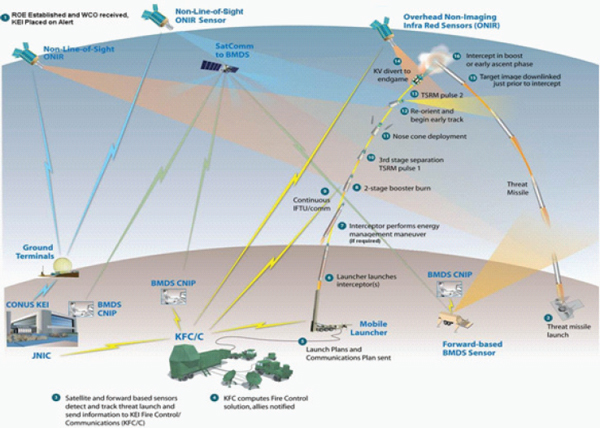
FIGURE 2-1 KEI system integration. BMDS, ballistic missile defense system; CNIP, C2BMC network interface processor; JNIC, Joint National Integration Center; ROE, rules of engagement. SOURCE: Craig van Schilfgaarde, David Theisen, Steve Rowland, and Guy Reynard, Northrop Grumman Corporation, “An Assessment of Concepts and Systems for U.S. Boost-Phase Missile Defense in Comparison to Other Alternatives: Northrop Grumman Perspective,” presentation to the committee, July 13, 2010. Courtesy of Northrop Grumman Corporation.
Airborne Laser
The ABL program was planned to provide a boost-phase defense capability against a range of missile threats. This is no longer a program of record for the MDA but has been downgraded to a research program called the Airborne Laser Test Bed (ALTB), an advanced program for the directed-energy research program. For the purposes of this report, ABL is referred to as if it could provide an operational defense capability; where appropriate, the differences between the original ABL and the present ALTB are noted.
The attractiveness of using directed-energy weapons, notably lasers, for boost-phase defense arises out of their potential to deliver a lethal dose of damage to a target at the velocity of light from long distances. The fundamental properties on which the choice of the laser depends include the wavelength, power output, efficiency of conversion of the primary energy into laser energy, and, of course, size and weight.
So, in principle, the laser is ideal for boost-phase intercept since it is able to project a large amount of power at the speed of light over several hundred kilometers onto a modest-sized (~1 m) spot. To capitalize on these benefits, MDA established the ABL program, which was proposed to consist of a large airframe (a modified Boeing 747-400F airplane) carrying a multimegawatt laser, known as the high-energy laser (HEL). The HEL beam is directed onto the boosting missile body for several seconds. During that time sufficient energy per unit area (fluence) is delivered to cause enough heating to result in mechanical failure of the missile body itself, thus disabling it and preventing the payload from reaching its target. The advantage of this system is that it delivers a lethal fluence to the threat missile in a matter of seconds from a great distance. Because the laser beam travels at the speed of light, the distance from which the threat can be intercepted is not limited by the flight time of a rocket interceptor. Rather, the range is limited by the fluence required, the laser power, and the ability to focus the beam onto the target at low elevation angles through the atmosphere. The ability to focus depends on the laser beam quality and issues of light propagation in the atmosphere itself. The beam propagation limitations are complex and are provided in the classified annex (Appendix J).4
Figure 2-2 displays key parts of the ABL system aboard the Boeing 747-400F. HELs are located in the body of the airframe, and the beam exits the plane at the nose, directed by a large (1.5-m-diameter) movable mirror in a turret.5 The beam may be directed anywhere within a sphere with a cone cut out in the backward and forward directions with respect to the line of flight. The mirror rotates
_____________
4David K. Barton, Roger Falcone, Daniel Kleppner, Frederick K. Lamb, Ming K. Lau, Harvey L. Lynch, David Moncton, et al., 2004. Report of the American Physical Society Study Group on Boost-Phase Intercept Systems for National Missile Defense: Scientific and Technical Issues, American Physical Society, College Park, Md., October 5.
5Ibid., p. S299.
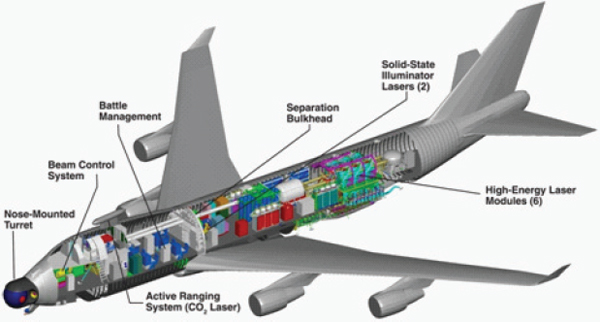
FIGURE 2-2 Cutaway of the ABL system showing its key parts. SOURCE: Col Laurence Dobrot, USAF, Missile Defense Agency, “Airborne-Laser System Program Office: Presentation to the National Academy of Sciences,” presentation to the committee, January 14, 2010.
within the turret so that the beam may be directed by up to about 120 deg from the line of flight.6 The turret rotates so that any angle around the line of flight may be chosen.
The ABL must be on station near the location from which the threat missiles would be launched. One or more ABLs would orbit in figure 8-like patterns in that vicinity. Such patterns allow an advantageous side-on view of the potential threat all of the time except when the airframe must turn at the end of the 8; however, a side-on or head-on attitude is always maintained by choosing the correct direction of circulation in the 8. The ABL would fly at an altitude of approximately 12 km in order to minimize the amount of atmosphere through which the beam must travel. For redundancy and for dealing with multiple launches, two ABLs would cover one threat area. Such redundancy would be necessary during refueling operations to avoid gaps in coverage.
The ABL would operate autonomously to identify threats by means of onboard IR sensors that detect the exhaust plume of the boosting missile. With knowledge of the location of the threat, the tracking illuminator laser (TILL) is activated to acquire the target, determine the exact aim point desired using the image of the nose, and provide illumination for first-order adaptive optics (AO) corrections. (Astronomers have used AO to at least partially cancel out atmospheric disturbances.) The beacon illuminator laser (BILL) places its beam
_____________
6Ibid., p. S339.
on the missile body, and that image provides the higher order correction information. Finally, the chemical oxygen-iodine laser (COIL) is activated with the HEL focused on the target for long enough to deliver the fluence required to induce mechanical failure of the missile. Mechanical failure results from heating a metal sufficiently to weaken it. It is not necessary to melt the metal to weaken it considerably. The failure itself may come from rupture due to pressure inside the container or from a loss of strength to resist the axial forces of acceleration of the boosting missile. There will probably be a clear optical signature of the mechanical failure to confirm the intercept. The signature may be an explosion or very erratic flight of the booster.
It is unlikely that the defense will know when a threat missile is likely to be launched. Therefore, the ABLs must be able to remain on station for extended periods. Providing continuous coverage will require in-flight refueling and a handoff to other airframes to relieve the crew or provide other maintenance for the airframe or its systems.
Other
Space-Based Interceptors
One problem of surface-based (i.e., on land, at sea, or in the air) KKVs is their access to the threat missile. There is a limit on how far a KKV can be based from the intercept point (not the launch point); this limit depends on the fly-out time of the interceptor and the burn time of the threat. A country that is large enough can deliver an array of missile threats that are not vulnerable to surface-based intercept in their boost phase. There may be political constraints on basing interceptors outside enemy territory, in neighboring countries. One way to avoid the geographic constraints suffered by surface-based interceptors is to base them in space, on platforms that carry one or several such interceptors. The enemy may thereby be denied all locations within the latitudes of the orbits. This is the attractive feature of space-based interceptors (SBIs).
At this time there is no program of record within MDA for SBIs. This report noted large differences in the size estimates of Lawrence Livermore National Laboratory’s (LLNL’s) KV and that of the more conservative estimate found in the 2004 American Physical Society (APS) report previously noted. The committee’s assessment of these differences and their validity are discussed in the classified annex (Appendix J). In short, the committee believes the LLNL KV was much lighter because it had much less divert velocity propulsion, apparently because it separated from the booster first stage much later than did the APS KV design. The committee believes the sizing methodology used in the APS report
is more realistic.7 In addition, MDA canceled the Space Test Bed program in its 2010 budget. Moreover,
in previous budgets, MDA had established the Space Test Bed to explore concepts for and to conduct research to support potential deployment of boost-phase intercept defenses in space. In the 2009 budget, MDA had planned to spend about $300 million for that research, and the Congressional Budget Office’s (CBO’s) projection of DOD’s plans, based on the 2009 future years defense plan (FYDP), incorporated the assumption that an operational space based interceptor system would be developed and fielded.8
The SBI platforms would be placed in multiple rings of satellites, with multiple satellites per ring.9 The orbits are inclined with respect to Earth’s equator, and the maximum latitude that the SBIs can cover is a little larger than the inclination angle. Such a constellation of satellites results in nonuniform coverage of the ground, where “coverage” means the number of satellites that are within range to deliver an SBI to a threat missile within the time window. Generally speaking, one wants to have at least one SBI within range, but it may be desirable to have more than one for redundancy or to deal with raids. There is substantially better coverage (i.e., more satellites within range) for latitudes near the orbit inclination angle and poorer coverage at low latitudes. However, coverage at latitudes above the orbit inclination rapidly drops to zero above the latitude of the inclination of the orbit.
Airborne-Based Interceptors
Recently, ABIs, also known as airborne hit to kills (AHTKs), have been reconsidered and show some potential applications in certain conflict scenarios. The primary difficulty with ABIs, like all other proposed kinetic boost-phase systems, is the need to be close enough (within about 50 km) to the target so that an interceptor with a given speed and a KKV of sufficient agility can reach and successfully home in on the accelerating booster before the boost phase ends. ABI programs have existed in the past, but today only a few low-end ABI systems based on existing interceptors remain on the drawing boards—for example, the network-centric airborne defense element (NCADE), based on a modified advanced medium-range air-to-air missile (AMRAAM) missile, and
_____________
7Ibid.
8Congressional Budget Office. 2004. Alternatives for Boost-Phase Missile Defense, Washington, D.C., July.
9The critical number for coverage is the average number of satellites within range, and that is well characterized by the product of the number of rings times the number of satellites per ring. The tradeoff between the number of rings and the number of satellites per ring for a fixed product is slowly varying. In addition, the satellites were assumed to have a service life of about 7 years and the disposal of expired platforms is not taken into account.
the air-launched hit-to-kill (ALHK) program, based on an air-launched version of the PAC-3 missile. These systems might be able to intercept boosting targets at very short range, but they rely primarily on aerodynamic forces for divert and, consequently, cannot intercept accelerating targets above approximately 30 km in altitude, where most of the boost phase occurs, especially for missiles with ranges beyond 1,000 km. Hence, they cannot provide a robust boost-phase intercept capability.
ANALYSIS
Overview
A boost-phase defense system is one that presumably avoids the midcourse countermeasure problem, provided the system can intercept the hostile missile’s burning booster rocket with its bright exhaust plume before the hostile missile reaches its desired velocity and deploys its payload. If such a boost-phase defense system can achieve that end within the extremely short engagement window available, it can protect a large area against launches from a specific locale. In principle, boost-phase intercept is technically feasible and appears attractive. To take an extreme example, a soldier with a 50-caliber machine gun or handheld rocket launcher 300 yards from a missile launch pad could easily destroy that missile as soon as it lifts off its launch pad. This is so for three reasons: (1) the soldier can see the hostile missile as soon as it emerges from its launcher; (2) the speed and acceleration of the hostile missile at that time are very low compared to the fly-out velocity of the soldier’s firepower; and (3) the hostile missile’s motion at that time is tracked by the soldier’s eyes and is predictable. For the same reasons, an Aegis SM-2 Block IV antiair missile can shoot down a short-range ship-launched Scud-type theater missile during boost if the Aegis ship is downrange within 50 km of the launch.
Unfortunately, trying to intercept a hostile booster rocket (solid or liquid propellant) from a significant distance dramatically turns the tables. For one thing, there is not much time between knowledge of where the hostile missile is directed and the time available for the interceptor to reach out to hit the target at a militarily useful range. This is compounded by the fact that the hostile missile is traveling at about the same velocity as the interceptor and its acceleration is less predictable. Even so, it is possible to guide a suitably maneuverable interceptor in order to hit a hostile thrusting booster, assuming the interceptor can get there in time.
As noted in Chapter 1, the committee had access to classified information provided by the Missile Defense Agency on its programs of record; however, the committee chose to develop a set of notional threat missiles, notional interceptor designs, and notional sensors to explore the basic physical limitations of missile defense system performance, with the understanding that a public report was
not only requested by Congress but also helps improve public understanding of ballistic missile defense issues. The following analysis is based, in large part, on notional data developed by the committee and is stated as such throughout this chapter. While boost-phase defense has been advocated as the most efficient way to deal with fractionated payloads and exoatmospheric (midcourse) penetration aids, such systems are extremely vulnerable depending on threat booster characteristics and operational considerations. The committee’s analysis of boost-phase defense concludes that it could be technically possible in some instances but operationally and economically impractical for almost all missions.
Time, Range, and Technical Constraints: Iran and North Korea as Examples
As previously noted, the committee’s analysis focused on assessing U.S. boost-phase defense systems against ballistic missile threats from Iran and North Korea. Figure 2-3 illustrates the dilemma for all boost-phase defense systems (i.e., the pressing intercept timelines for both solid and liquid threat booster rockets) and specifically displays this dilemma for what most boost-phase defense advocates would call the less onerous of the two ballistic missile defense problems—that is, defense against ICBMs launched from North Korea). Moreover, advocates for boost-phase defense would argue that because of North Korea’s relatively small size and proximity to a coastal boundary, Aegis ships along with military aircraft could get fairly close to the threat boost trajectories in order to minimize the reach required. In Figure 2-3, it is assumed that the threat was detected at an altitude above the cloud cover, which we would assume to be 30 sec after launch of a notional solid-propellant missile and 45 sec after launch of a notional liquid-propellant missile.
In understanding the challenges of boost-phase defense of the U.S. homeland and Canada, it is helpful to begin by looking at the ground tracks of trajectories on the rotating Earth from launch to impact and where an ICBM payload lands as a function of where its boost is terminated. Figure 2-4 shows the ground tracks of ICBMs launched from Iran and North Korea to reach the United States.10
While it is convenient to describe missile performance in a standard way, that is, on a nonrotating Earth basis—it is important, particularly for longer range threats, to consider rotating Earth effects. This is important both for assessing what territory is at risk for a given threat missile performance and for looking at the ability to engage such threats during their boost or early midcourse phase of flight. While there are additional second-order Earth effects—such as Earth’s oblateness (nonspherical shape) and local gravity variations—which must be considered in accurate targeting, these are not of importance for this discussion.
_____________
10Figures 2-4 to 2-8 and Figures 2-11 to 2-16 were generated from the committee’s analysis using Google Earth. © 2011 Google, Map Data©2011 Tele Atlas.
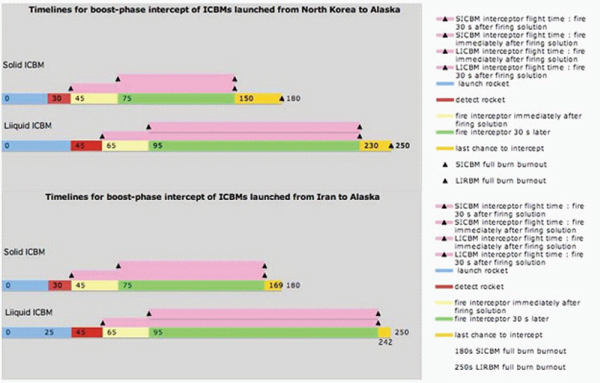
FIGURE 2-3 Timelines for ICBM boost-phase intercepts of ICBMs launched from North Korea (upper) and Iran (lower). Based on data from David K. Barton, Roger Falcone, Daniel Kleppner, Frederick K. Lamb, Ming K. Lau, Harvey L. Lynch, David Moncton, et al., 2004. Report of the American Physical Society Study Group on Boost-Phase Intercept Systems for National Missile Defense: Scientific and Technical Issues, American Physical Society, College Park, Md., October 5, pp. S23 and S80.
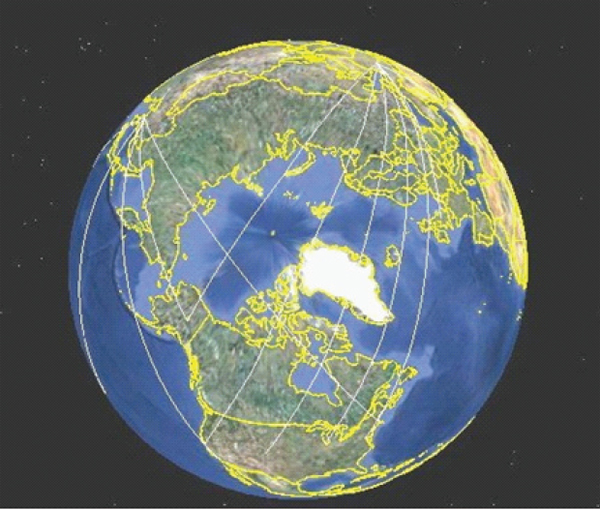
FIGURE 2-4 Notional trajectories for ICBMs launched from Iran and North Korea toward North America.
When a ballistic missile flies due north, the effect of Earth’s rotation on range is small (2-3 percent), affected by the launch azimuth required to account for the initial missile velocity owing to Earth’s tangential velocity at the launch point and also to lead the target, which moves during the flight time of the missile. When a missile is launched in an easterly direction, Earth’s rotation increases the maximum range of the missile relative to its nonrotating Earth descriptor.
Conversely, when launched in a westerly direction, Earth’s rotation reduces the reach of that same missile. Intuitively the opposite should be true since the target movement from west to east during the roughly 30-40 min flight time of the missile (~7.5 degrees of longitude, or ~800 km at the equator) would be the dominant effect. However, keeping in mind that an ICBM has a burnout velocity of 6.5-7.4 km/sec or so, Earth’s tangential velocity at the launch point (almost 0.5 km/sec for a launch point at the equator) has a much greater effect on the effective range of the missile than the distance the target moves during the flight time.
For example, if a missile with a nonrotating Earth range of 12,000 km is launched from the center of Iran and flies almost due north, the actual ground
range, including Earth rotation effects, is close to the range for a nonrotating Earth. Thus that missile is able to strike Seattle, approximately 12,000 km away. On the other hand, that same missile launched against the East Coast has a launch azimuth of about 315 degrees (45 degrees west of north), and that same missile can only reach a great circle range of about 10,000 km. To reach all of Florida or Texas at a great circle range of 12,000 km, a nonrotating range capability in excess of 14,000 km would be required.
These differences are important for three reasons. First, when the threat posed to the United States is assessed, the actual ground range reach is an indicator of an adversary’s goals. Second, since the longest ground range needed determines the minimum energy trajectory for a given missile, a longer range with its lower flight path angle and altitude at boost termination as well as in midcourse flight, this range also determines the reach required for early intercept of an ICBM aimed at the United States or an IRBM aimed at northern Europe from a site in the Middle East (see Figure 2-4).
Third, Earth’s rotation between the time of launch of the threat from any given point until the launch of an interceptor sited to counter that threat affects the trajectory of the interceptor needed for earliest and latest engagement of that threat as well as the footprint that can be defended. For the purposes of this study, the maximum range of a missile is the distance to which it can fly a given payload mass and constraints on its boost trajectory such as (1) the maximum dynamic pressure, which typically establishes the heating and thermal protection for structure and controllability requirements due to wind shears, and (2) the dynamic pressure at first-stage separation, which determines control requirements to recover from deviations in angle of attack due to first-stage-thrust tail-off.
Figure 2-5 shows contours of thrust cutoff time (with a total burn time of 250 sec) for a representative two-stage liquid ICBM with a maximum nonrotating Earth range of 12,000 km that is launched from the safest location in North Korea. Figure 2-6 then shows similar contours for a representative solid propellant ICBM of the same maximum range with a maximum burn time of 180 sec. Moreover, the analysis shows that a boost-phase defense system emplaced for protecting the western third of the United States and mainland Alaska would need to intercept a North Korean-launched ICBM that uses liquid propellant at about 230 sec (or 20 sec before burnout) and one that uses solid propellant at 150 sec (or 30 sec before burnout).
A similar analysis is provided for Iran. Specifically, Figures 2-7 and 2-8 show similar contours for ICBMs launched from central Iran; however, the ICBM range must be more than 13,300 km because the missiles, particularly those targeting the East Coast of the United States, would be launched in a northwesterly direction and their reach would be reduced by the effects of Earth rotation. In summary, the analysis shows that a boost-phase defense system emplaced for protecting Alaska is the most stressing case and would need to intercept an Iranian-launched ICBM using liquid propellant at about 242 sec (or 8 sec before
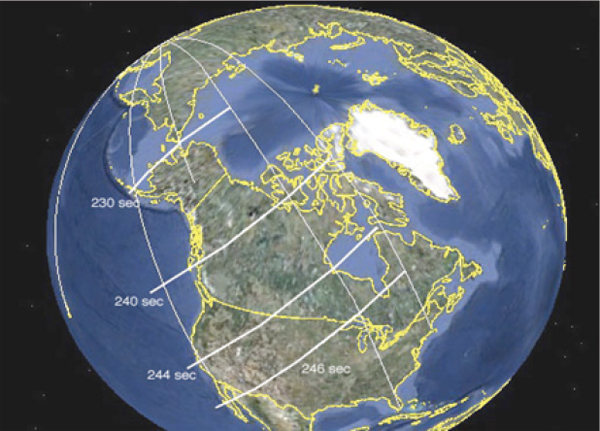
FIGURE 2-5 Thrust cutoff time contours for a notional two-stage liquid ICBM with an assumed total burn time of 250 sec and a maximum nonrotating Earth range of 12,000 km launched from North Korea.
burnout) and one using solid propellant at 169 sec (or 11 sec before burnout) for the notional ICBM designed used in this study.
Up to this point, the analysis has shown the pressing time constraints for achieving boost-phase intercept against a notional ICBM—solid or liquid propellant—launched from Iran or North Korea toward the United States (including Alaska) and Canada. Now, the reach of any given interceptor is calculated. To assess terrestrial-based kinetic boost-phase defense, the committee chose two sizes of interceptor. The first was a notional 6 km/sec fly-out velocity, 70-sec burn interceptor without a third stage.
The second was a notional 4.5 km/sec fly-out velocity interceptor that could be carried in the vertical launch system (VLS) Aegis system. It also could be carried and launched by a tactical aircraft. These two interceptors, carrying a KV with the necessary agility for the boost-phase missions, were used to understand engagement performance for both Iran and North Korea.
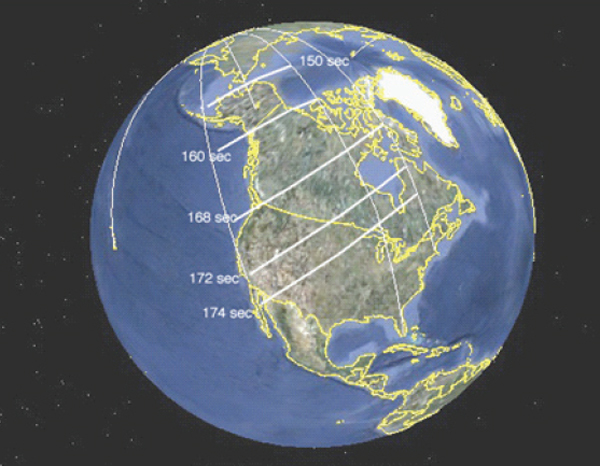
FIGURE 2-6 Thrust cutoff time contours for a notional three-stage solid ICBM with an assumed burn time of 180 sec and a maximum nonrotating Earth range of 12,000 km launched from North Korea.
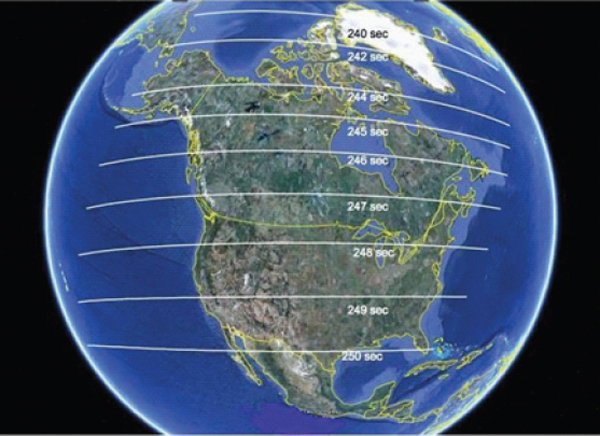
FIGURE 2-7 Thrust cutoff time contours for a notional two-stage liquid ICBM with a maximum nonrotating Earth range of 13,300 km that is launched from central Iran.
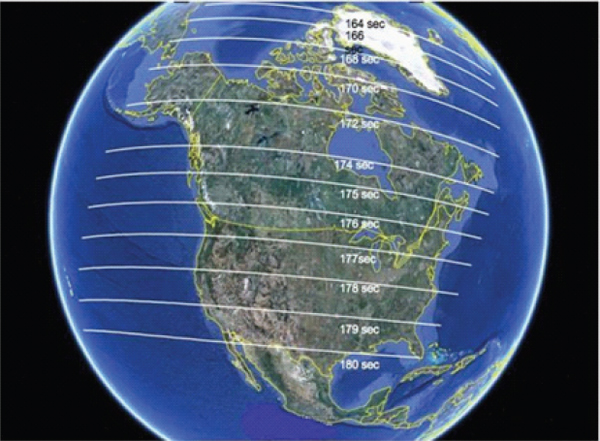
FIGURE 2-8 Thrust cutoff time contours for a notional three-stage solid ICBM with an assumed burn time of 180 sec and a maximum nonrotating Earth range of 13,300 km launched from central Iran.
Figure 2-9 shows how the reach of the interceptor is calculated.11 Here, head-on (coplaner) engagements define the maximum reach that an interceptor of a given fly-out velocity launched at the earliest opportunity would have to kinetically engage the hostile missile at the desired time. This maximum reach, R, applies to any interceptor launched within a circle with radius R, derived from a projection of the desired intercept point on the ground track. Figure 2-10 shows an example of a coplanar, or head-on, engagement for the notional 6 km/sec interceptor against a North Korean liquid ICBM that was modeled and then used like the preceding construction example to determine the general case of engagement at any aspect angle.12 The interceptor fly-out contour times are referenced to the
_____________
11See David K. Barton, Roger Falcone, Daniel Kleppner, Frederick K. Lamb, Ming K. Lau, Harvey L. Lynch, David Moncton, et al., 2004, Report of the American Physical Society Study Group on Boost-Phase Intercept Systems for National Missile Defense: Scientific and Technical Issues, American Physical Society, College Park, Md., October 5.
12The boost-phase intercept problem is dominated by the challenge of the short burntime of solid fuel rockets. However, North Korea currently uses slower burning liquid fuels. Since the North Korean threat has been the focus of much U.S. homeland defense work, this constrained threat is worth analysis. It must, however, be kept in mind that North Korea could shift to solid fuel, possibly with external assistance, in an effort to frustrate U.S. defenses.
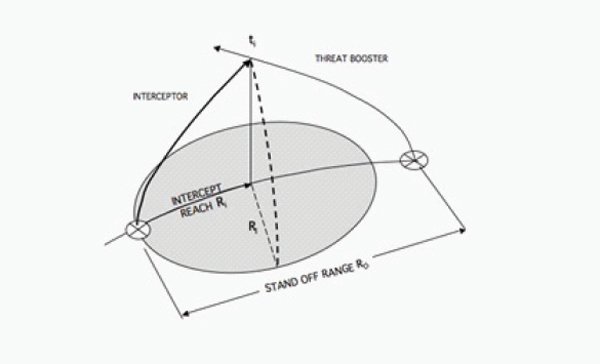
FIGURE 2-9 The boost-phase engagement—calculating reach of the interceptor. SOURCE: Based on data from David K. Barton, Roger Falcone, Daniel Kleppner, Frederick K. Lamb, Ming K. Lau, Harvey L. Lynch, David Moncton, et al., 2004, Report of the American Physical Society Study Group on Boost-Phase Intercept Systems for National Missile Defense: Scientific and Technical Issues, American Physical Society, College Park, Md., October 5.
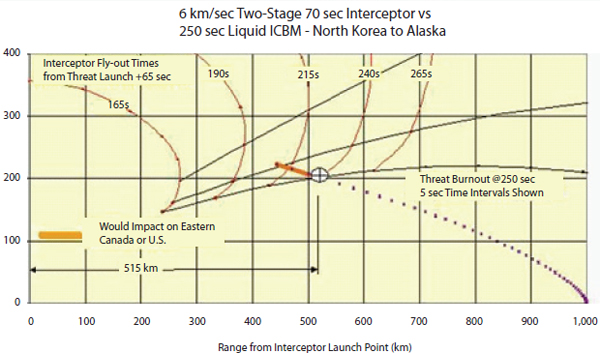
FIGURE 2-10 Fly-out fan for a notional 6 km/sec interceptor engaging a liquid-propellant ICBM head-on to determine R.
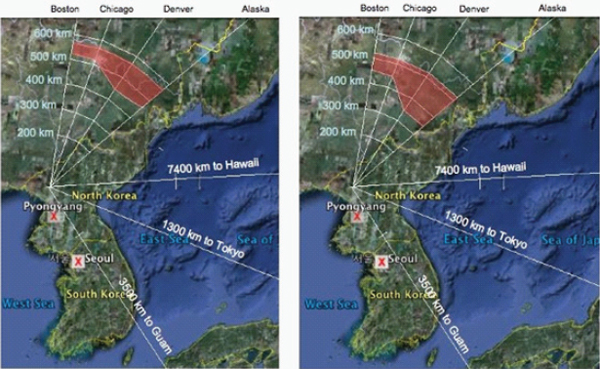
FIGURE 2-11 Illustrative boost-phase ground tracks for notional ICBMs to various parts of the United States from North Korea: (a) notional liquid ICBM and (b) notional solid ICBM.
detection at an altitude of 7.5 km plus 15 sec in accordance with the timeline in Figure 2-3 to allow the missile to develop enough horizontal velocity so the sensor can select a rough point at which to commit an interceptor without a high risk of wasting it by exceeding its divert capability during boost. The range from interceptor launch point is shown to be about 515 km for intercept at a time after launch from North Korea, consistent with avoiding impacts on North America.
Using planar engagement simulations like the one shown in Figure 2-9, it is possible to calculate the greatest distance (or reach, R) to the earliest point at which a kinetic interceptor with a given fly-out velocity could engage a hostile missile. A view over the North Korean launch point in Figure 2-11 shows the azimuth and boost ground tracks to various parts of the United States (noted at the top of the figure) for notional liquid- and solid-propellant ICBM threats from North Korea. One can see where intercepts must occur geographically in order to defend North America against such threats.
The red region is the ground range where threat boost termination would result in impacts in the United States and Canada. It applies to all boost-phase intercepts regardless of basing. The northern edge of the red zone is where the burnout for maximum range occurs. The southern edge is the cutoff times derived from the impact contour charts. Ground range from the launch site is shown for reference. The solid threat burns out at 519 km from its launch point, and the liquid threat burns out about 575 km from the launch point. The launch point was
chosen to maximize the difficulty of both intercepts and attacks on the launch site for their adversaries. The more easterly fly-outs show the need for earliest intercept of ICBM threats to Alaska. Also shown for reference are ground tracks and ranges to Hawaii, Tokyo, and Guam.
Land-, Sea-, or Air-Based Kinetic Boost-Phase Defense
The committee first examines the requirements and limits for terrestrial-based boost-phase interceptors. In all cases, these interceptors are constrained by geography and sovereignty to basing that is militarily and politically viable. Figure 2-12 shows where these same boost-phase defense systems would need to be emplaced in order to kinetically engage liquid-propellant ICBMs aimed at America; Figure 2-13 shows this information for solid-propellant ICBMs.
In both Figures 2-12 and 2-13, the launch point for the notional ICBMs launched from North Korea was chosen to make intercepts and attacks on the launch site the most difficult—that is to say, the safest locations, as shown in
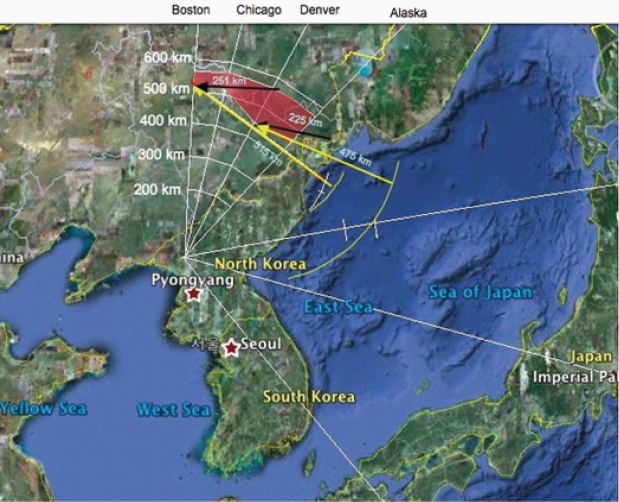
FIGURE 2-12 Notional interceptor ranges to kinetically engage a liquid-propellant ICBM launched from North Korea. Yellow and black arrows represent fly-out velocities of notional 6 km/sec and 4.5 km/sec interceptors, respectively.
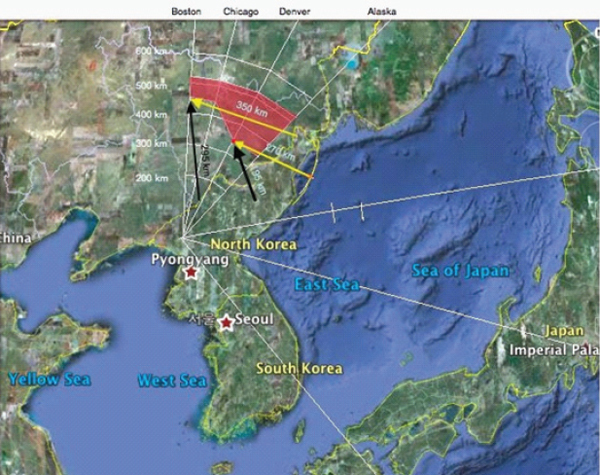
FIGURE 2-13 Notional interceptor ranges to kinetically engage a solid-propellant ICBM launched from North Korea. Yellow and black arrows represent fly-out velocities of notional 6 km/sec and 4.5 km/sec interceptors, respectively.
Figures 2-11. Figure 2-12 shows the radius of the arcs within which notional interceptors with fly-out velocities of 4.5 km/sec (shown as black arrows) and 6 km/sec (shown as yellow arrows) must be based in order to intercept before the red zone is reached. It can be seen that even with no decision time, (1) no 4.5 km/sec terrestrial interceptor can engage in boost-phase intercept even against slow-burning liquid ICBMs unless it is launched from China or North Korea itself and (2) the 6 km/sec interceptor, if based on a ship, can engage the more easterly liquid ICBM trajectories, but to engage the more western trajectories headed to eastern North America it would have to be so close to the North Korean coast as to be highly vulnerable to attack.
Engaging notional solid-propellant threats from North Korea is even more constrained, as shown in Figure 2-13. Reaching even the more easterly notional threat trajectories requires a 6 km/sec interceptor to be based unacceptably close to the adversary’s territory. Note that the reach of the 4.5 km/sec interceptor is greater against notional solid ICBMs than against liquid ICBMs even though solid burn times are much shorter. This is because the notional liquid boost
trajectories are of lower altitude and the 4.5 km/sec interceptor cannot get low enough at longer range to engage the notional liquid-propellant threat at a greater distance.
Because of their shorter burn times and lower burnout altitudes, it is not feasible to intercept notional short- and medium-range missiles with ground- or sea-based versions of the two interceptors or space-based interceptors in the exoatmosphere. Intercepting notional missiles of 2,000 km range or less during boost would require interceptors that can engage within the atmosphere, and those interceptors would have to be close to the threat launch point. One such example is a notional 1,300 km single-stage missile aimed at Tokyo. Here, boost-phase intercept of such an attack is infeasible with a platform outside North Korea’s airspace.
The committee found only one case of a notional ICBM launched from North Korea against Hawaii that could be engaged during boost phase by a notional 4.5 km/sec interceptor, provided it has a more agile KV than currently planned.
In summary, Figure 2-12 shows that a notional North Korean-launched liquid-propellant ICBM aimed at the East Coast would be the most pressing challenge for a boost-phase defense system to kinetically engage. Moreover, a ground-based boost-phase interceptor with a nominal speed of 6 km/sec would have to be based at sea or in China to reach the boost phase of a notional North Korean liquid-propellant ICBM. However, a notional 6 km/sec interceptor appears to be too large to be carried in the Aegis vertical launch system (VLS) or on a tactical aircraft. From Figure 2-13 it is evident that a notional 4.5 km/sec interceptor has no viable boost-phase capability against a notional solid ICBM unless it overflies North Korean airspace and that even a notional 6.0 km/sec interceptor, when sea based, has little room to maneuver, and then for only a limited azimuth of threat launches.
One can conclude then that, until otherwise demonstrated, no airborne or Aegis VLS-based interceptor could be used for boost-phase defense against notional ICBMs aimed at the United States, even against a country that is as small as North Korea and that is accessible by sea, unless those interceptors are based on or over neighboring territory or over the threat country itself. However, a possible application limited by the interceptor fly-out envelope and on-station endurance is the engagement of notional longer range missiles launched from North Korea against Hawaii or other Pacific Ocean targets where the boost trajectories are headed toward international waters or allied territories and where boost-phase interceptors can be stationed.
A similar analysis is provided for notional ICBMs launched from Iran and aimed at North America. Figure 2-14 shows the fly-out ground tracks and azimuths for notional liquid- and solid-propellant ICBMs launched toward North America from central Iran. The launch location is assumed to be central Iran. As with North Korea the red zone is the zone in which a velocity has been reached that would allow impacting the area being defended. Threats must be engaged in
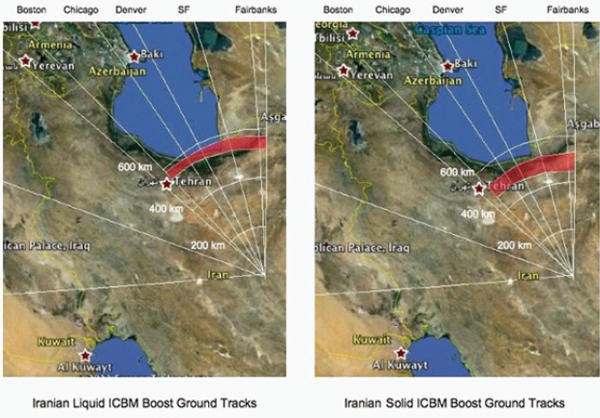
FIGURE 2-14 Fly-out ground tracks and azimuths for notional liquid and solid ICBMs launched toward North America from central Iran.
their boost phase before reaching that zone regardless of where the interceptor is based. Also shown are ranges and azimuths to Israel and Gibraltar.
Figures 2-15 and 2-16 illustrate the problem of engaging notional long-range ballistic missiles launched from Iran (Figure 2-15 is for liquid-propellant ICBMs whereas Figure 2-16 is for solid-propellant ICBMs). Again, the black arcs represent the reach for a notional 4.5 km/sec interceptor against a notional liquid ICBM. No matter whether the ICBM is headed to North America, as shown, or to Europe, a 4.5 km/sec interceptor would have to be based in the Caspian Sea or in neighboring territory in Turkmenistant to be able to catch liquid ICBMs in their boost phase. Even a notional 6 km/sec interceptor would have to be in the Caspian Sea or in neighboring territory in Azerbaijan or Turkmenistan. No effective boost-phase defense of Europe or the Middle East is possible because of the shorter burn times associated with medium- and intermediate-range ballistic missiles and the fact that Iran could arrange to launch the attack from locations such that no boost-phase interceptor could be in range from outside Iranian airspace. There has been some discussion of the use of stealthy aircraft or unmanned aerial vehicles (UAVs) carrying interceptors loitering in the southern Caspian; however, because of the limited reach of airborne boost-phase interceptors and the fact that even stealthy airborne platforms could potentially be vulnerable to air defenses, such concepts seem impractical at the current time.
For notional solid ICBMs launched from Iran the possible basing area shrinks
even more for the notional 6 km/sec interceptor, but the reach of the notional 4.5 km/sec interceptors actually increases somewhat. While this is counterintuitive, it is so because in this case, the trajectory of a liquid ICBM in its boost phase is significantly lower than that of a solid ICBM such that the interceptor cannot launch until it can engage at an altitude it can enforce. Accordingly, with one or two exceptions, terrestrial-based boost-phase defense systems do not appear attractive given the timeline and geopolitical constraints.
Directed-Energy Boost-Phase Defense
The range and time constraints on boost-phase defense using kinetic intercept is one reason for the interest in the use of directed-energy weapons for boost-phase defense.13 The ABL was designed to exploit the delivery of energy at the speed of light to perform the boost-phase intercept mission. Space-based lasers have also been pursued. Virtually no fly-out time is involved, although dwell time on target is involved, and the beam agility is a function only of how fast the pointing optics can be repositioned. While laser weapons sound like the obvious answer, the irradiance (power per unit area) that a laser can deliver on a distant target is ultimately limited by the power of the laser and the diameter of the exit optics of the device. In reality, atmospheric effects will substantially disturb the propagation of the beam to a degree that increases rapidly with the distance traveled through the atmosphere. Much has been accomplished, however, in developing pointing and tracking capabilities and adaptive optics to maintain beam quality.
While laser energy is transmitted at the speed of light, the damage mechanism for continuous wave lasers is the heating of materials to failure, which requires a certain dwell time. The amount of energy delivered per unit time is determined by the energy density of the prime energy source and by the limits on the size and weight of the hardware to convert that primary energy into a beam and project it. These limit the practical power, aperture, and endurance of lasers that can be carried on real platforms.
In the end, even though laser propagation is nearly instantaneous, the dwell time to heat the target is substantial and, depending on the target material and coupling efficiency, takes several seconds, even in the absence of countermeasures to harden the booster against laser attack. With countermeasures, the challenge is greater. Raid missile launches stress the ABL. In the CONOPS there would be at best two ABLs flying in a single combat air patrol (CAP) within range of the missiles, and each ABL can engage only one threat at a time. There is a limited window of opportunity to effect intercepts in which the missile is high enough to have a thin enough air column in the laser’s path for long-range propagation and before the threat burns out. In short, the ABL has a limited number of shots
_____________
13Additional information and analysis can be found in the classified annex (Appendix J).
without refueling the laser. The slewing from one target to another can be done in a relatively short time.
There are other limits to the useful range of high-energy lasers for boost-phase engagements. Even at the speed of light and the relatively thin atmosphere at the operating altitude of the ABL, atmospheric effects degrade the coherence of the beam unless variations in the structure of the atmospheric path from the laser to the target are compensated for in real time. This requires leading the target, and, even at the speed of light, the round trip of the calibration beam limits the effective range.
When a laser such as the ABL (now renamed the airborne laser test bed (ALTB)) is based on an aircraft, it is propagated through the atmosphere over a substantial distance, albeit at lower densities than propagation on the ground. Thus the properties of the atmosphere vis-à-vis the laser wavelength are very important. These properties include the absorption, scattering, and turbulence. Those wavelengths that are strongly absorbed by the constituents of the atmosphere are inappropriate for long-distance propagation. Notably, these are the wavelengths absorbed by atmospheric water vapor, carbon dioxide, carbon monoxide, oxides of nitrogen, and so forth, and they are ruled out. Fortunately, there are several windows in the atmospheric transmission where absorption is small enough to allow radiation to be propagated over hundreds of kilometers. The early lasers, starting with the carbon dioxide, hydrogen fluoride/deuterium fluoride (HF/DF), and COIL lasers, were chosen because their wavelengths were in such low-loss atmospheric windows.14
While the exact design power cannot be provided in this unclassified report, MDA describes the ABL as a multimegawatt laser and the ALTB as a megawatt-class laser. By the early part of 2010, the ALTB HEL had achieved about 80 percent of the Tail 1 design power. This performance can be improved, but substantial effort would be required.15 This does not appear to be a high priority at this time for MDA, and correctly so.
Inhomogeneities in the density of the atmosphere, called “turbulence” for short, result in inhomogeneities in the index of refraction. In turn, these variations perturb the propagation of a laser beam. A beam that would have been focused in a uniform atmosphere will no longer be focused. This is a problem well known to astronomers who use ground-based telescopes. The best solution for astronomers is to avoid the atmosphere and have the telescope in space—as, for instance, the Hubble Space Telescope—eliminating the problem. In the same way a laser weapon would be space based. For operation in the atmosphere, one would try to minimize the distance the beam travels through the atmosphere. Thus, a high flying aircraft is a much better platform than a device on the ground. There is a
_____________
14Additional information on the ABL/ALTB, including wavelength selection, is provided in the classified annex (see Appendix I).
15Missile Defense Agency. 2010. “ALTB Questions in Preparation for March 16-18 Presentations to the National Academy of Sciences,” March 17.
practical limitation on the altitude at which a very massive laser may be flown and kept aloft for many hours at a time. This limit is about 12 km for the 747-400F airframe and the load that it must carry.
Minimizing the atmosphere is not sufficient, however, and other measures are required. Astronomers have used AO to at least partially cancel out atmospheric disturbances, achieving great improvements in imaging. These phase distortions can be applied using a deformable mirror, but there are limitations on how well this works.
It is convenient to distinguish between two classes of AO errors and corrections: (1) first order and (2) higher order. These describe the variation of the phase error across the aperture. First-order (i.e., linear) errors cause an apparent movement of the whole image with time as the atmosphere changes, because the phase error is linear across the aperture. This is a prism distortion. Left uncorrected, the object is not positioned where it appears to be. Because of the time variation, this blurs the image over the time of exposure. Usually, the first-order error is the most serious. It can be compensated for by a simple, flat mirror that tips or tilts, keeping the image in the same place. Second-order (quadratic) and higher errors are defocus and two types of astigmatism. They are corrected using a deformable mirror whose local shape can be varied in compensation. These corrections are also time dependent. The higher order corrections are much more complex, but also important.
The ABL makes its AO corrections using two different systems. To make a first-order correction, the nose of the target missile is illuminated with a TILL and the edges of the nose image are used to define the position of the target. The TILL is a kilowatt-class solid-state laser that instead of being focused on the target, illuminates it with a meters-wide beam to see the geometrical edges. In turn, the first-order phase distortion derived from the nose image is applied to a planar mirror for the HEL beam to correct this error. To deal with higher order errors, a second kilowatt-class laser (BILL) provides a beacon on the body of the target. The wavefront of this image is processed, and the phase corrections are applied to a deformable mirror to correct the HEL beam.
For various reasons, one of which was the ABM Treaty, the ABL was designed for use against short-range theater missiles, not long-range missiles like ICBMs. Because the long-range missiles burn longer and burn out at higher altitudes, more of the optical path goes through less of the turbulent atmosphere. Consequently, the AO problem is much easier to solve. In turn, this means that the effective range of the ABL can be greater for long-range missiles than for short-range missiles.
In principle an advantage of the ABL is that aircraft could be deployed to respond to an evolving threat. This could be simpler than deploying an entire ground-based interceptor base. However, the redeployment of an ABL CAP would require enough aircraft to maintain an aircraft on station at the previous threat area(s). In addition, ABLs require substantial infrastructure on the ground for supply and maintenance. Thus, such a redeployment is by no means trivial.
The original plan for the ABL program called for two developmental aircraft, one of which, known as Tail 1, exists. A second development aircraft, designated Tail 2, was planned. Both Tail 1 and Tail 2 were intended as research tools, not as operational weapons. It was anticipated that once the development was complete, a fleet of seven operational aircraft would be acquired for a single CAP. This would allow the ABL to be used for boost-phase defense at one site.
The Air Combat Command (ACC) CONOPS document for the defense against one threat location (within the coverage of a figure-eight flight pattern) would require seven aircraft.16 Of the seven, five would be needed to keep two aircraft on station 24/7, and two would be in maintenance. If the maintenance has not included any laser or chemical operations, the aircraft can be rapidly turned around for another sortie until ~23 hr of engine run time accumulates, at which point engine oil servicing is required. If there have been laser or chemical operations, 24 hr are required between sorties.17 A standard crew shift would normally be limited to 12 hr to avoid fatigue. A single fuel load can keep the aircraft aloft for 7 hr at about 12 km. Without refueling, 1 hr of that time would be for transit from base to station, 5 hr on station, and 1 hr to return to base. With refueling, there would be one refueling during a single crew shift. A report from the Director of Operational Test and Evaluation (DOT&E) notes that refueling time is about 1 hr, so the total time on station would be 12 – 1 – 1 – 1, or 9 hr for a 12-hr mission.18 From this, it is easy to see that at least five flight-ready aircraft would be needed to keep two on orbit with redundancy to cover some gaps.
Clearly it would be very important to establish air supremacy over the enemy territory where the ABLs would fly. The ABLs are very high-value assets, and they would be high-priority targets for an enemy attack. MDA has suggested that the ABLs could fly with escort aircraft to deal with conventional aircraft.19 The committee does not concur with this suggestion. The long-term escort of unarmed assets is not supported by Air Force policy. MDA has also suggested that the ABLs have some self-defense capability, but the committee has not been told how that function would fit into the CONOPS. There is an obvious vulnerability, because the laser weapons cannot defend the rear of the aircraft.
A different and more challenging threat to the ABLs would be long-range surface-to-air missiles (SAMs). Simply staying out of range of SAMs may prevent an ABL from attacking an enemy’s missile. The use of onboard self-defense systems similar to those on other operational aircraft has been suggested, but the committee has no information on the efficacy of such measures for this applica-
_____________
16DOD Office of Testing and Evaluation. 2010. “Airborne Laser (ABL) Assessment of Operational Effectiveness, Suitability, and Survivability,” January.
17Missile Defense Agency. 2010. “ALTB Questions in Preparation for March 16-18 Presentations to the National Academy of Sciences,” March 17.
18DOD Office of Testing and Evaluation. 2010. “Airborne Laser (ABL) Assessment of Operational Effectiveness, Suitability, and Survivability,” January.
19Missile Defense Agency. 2010. “ALTB Questions in Preparation for March 16-18 Presentations to the National Academy of Sciences,” March 17.
tion.20 The ABL’s weapons are not well suited for attacking an incoming SAM, and they would offer no defense at all for an attack beyond the field of regard of the turret for the rear 120 degrees of azimuth. Ideally, establishing air supremacy would include taking out all the air defenses like SAMs.
Establishing air supremacy before the outbreak of hostilities would be very provocative and could itself lead directly to hostilities. Thus, it is more likely that the ABL would be used only after hostilities had begun, and that it would therefore be of limited value in stopping the first attack from an enemy.
Space-Based Boost-Phase Defense21
Space-based boost-phase defense can avoid the geographic limitations of terrestrial systems and can in principle engage even ICBMs from a large country. However, it would require hundreds and perhaps several thousand interceptors stored in orbit and would be more than 10 times as expensive than any other defense alternative.
Because geography is a fundamental constraint on terrestrial-based boost-phase defenses, advocates for space-based boost-phase intercept argue that putting the interceptors on orbiting satellites eliminates that constraint. On the other hand, a spaced-based system would face two other daunting constraints. Like all other proposed boost-phase defense systems, they must get from their orbital bases to the threat missile just as fast, with the same very short decision times, and to be close enough to do so. If the interceptors are to be constantly in a position to intercept, many platforms would be needed that must obey the laws of orbital mechanics. In addition it would be very expensive to put them into orbit and sustain them there in the first place.
Figure 2-17 illustrates how SBIs fly out from their storage orbit to engage ascending missiles during their boost. The SBI circles Earth in its storage orbit at some velocity and altitude. When dispatched to intercept a missile during boost, the SBI fires, adding more velocity to reach the threat. That fly-out velocity can be added in any direction after the interceptor is dispatched at t0. While space-based interceptors do not have to deal with flying out through atmospheric drag, and therefore for similar fly-out velocities can be smaller, they have to be boosted into orbit along with their host vehicle or garage. There is therefore a very great sensitivity to each kilogram of mass in the space-based interceptor, particularly in the kill stage. Specifically, after being boosted into orbit, the kill stage must be flown out from the orbiting garage at high acceleration and greater velocity in order to maximize its reach in the optimum-sized constellation. The result is a need for hundreds of SBIs to handle just the relatively slow liquid-propellant
_____________
20Ibid.
21Additional information and analysis can be found in the classified annex (Appendix J).
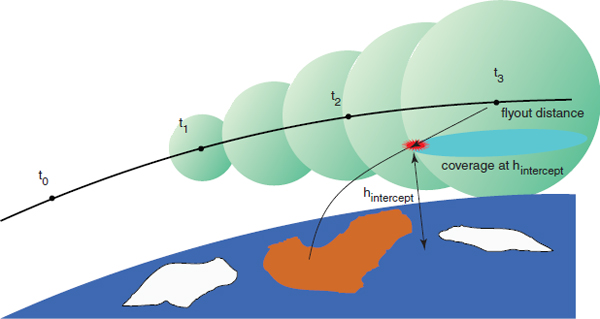
FIGURE 2-17 Area and volume coverage from orbit of space-based interceptors. SOURCE: Adapted from Figure 4.12 in David K. Barton, Roger Falcone, Daniel Kleppner, Frederick K. Lamb, Ming K. Lau, Harvey L. Lynch, David Moncton, et al., 2004, Report of the American Physical Society Study Group on Boost-Phase Intercept Systems for National Missile Defense: Scientific and Technical Issues, American Physical Society, College Park, Md., October 5, p. S60.
threats, and 2,000 or more to have a shot at the faster solid-propellant threats during their boost. Constellation sizing trades are discussed next.
Nations like North Korea and Iran lie between 25 and 42 degrees north latitude. Missiles fired from those countries toward the United States will burn out several hundred kilometers further north. So, the number of satellites required in the constellation is that number needed to always have at least one (and preferably two) close enough to reach a booster after it is launched—in all cases before booster burnout but (like all other boost-phase intercepts) before it reaches the velocity that would hit an area one wants to avoid—certainly Canadian or U.S. territory and, probably also, Russian or Chinese territory.
The laws of orbital mechanics mean that the minimum number of space-based interceptors must be in inclined orbits of at least 45 degrees. The population of SBIs is determined once again by the fly-out speed of the orbital interceptor and the time available, taking decision time into account, for the orbital interceptor to get from its storage orbit to the threat at its fly-out speed. This in turn defines the so-called absentee ratio—that is, the total number of interceptors required to be orbiting Earth every 90 min or so to assure that at least one is close enough to engage a single threat missile launched at any time. Even if it is assumed that North Korea would deploy only slow liquid-fueled missiles like those that it currently uses, several hundred satellites would be required in the constellation
to have a reasonable probability of engaging a single threat missile. If and when these countries apply the solid rocket technology that Iran is pursuing—a natural response to such a defense deployment—several thousand interceptors would need to be maintained in orbit.
Figures 2-18 and 2-19 show the probability that one or more satellites are within range P (≥ 1) and the probability that two or more satellites are within range P (≥ 2) as a function of the number of satellites in the constellation (Nsat). The probabilities are shown for decision times of 0 and 30 sec, and for notional 5.0 km/sec interceptors. The upper figure is for solid-propellant ICBMs and the lower figure is for liquid-propellant ICBMs. The assumed threats are for ICBMs launched from Iran. These cases are more stressing than launches from North Korea, even though the timeline is longer, because the greater concentration of satellites at the higher latitude of North Korea improves the coverage. The lead time for a country like North Korea to develop solid-propellant missiles is likely to be shorter than the time to develop and deploy a space-based defense system, which would probably be obsolete before it is deployed. Figure 2-20, created from a Monte Carlo simulation, illustrates what a space-based constellation of 1,600 satellites would look like, although even this constellation is not quite large enough to handle both liquid- and solid-propellant ICBM threats. The cost of a system capable of protecting against a single launch at a time is prohibitive. Consider, then, what would be required to deal with a simultaneous salvo of threat launches, a tactic that both North Korea and Iran have been practicing. Unless the constellation is populated sufficiently to handle salvos, there will be much leakage.
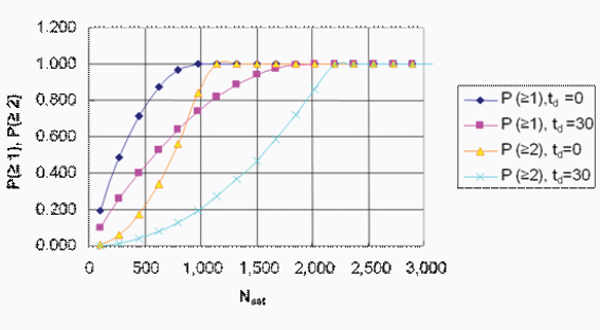
FIGURE 2-18 Probability as a function of the number of satellites in the constellation for a solid-propellant ICBM launched from Iran and notional 5.0 km/sec interceptors.
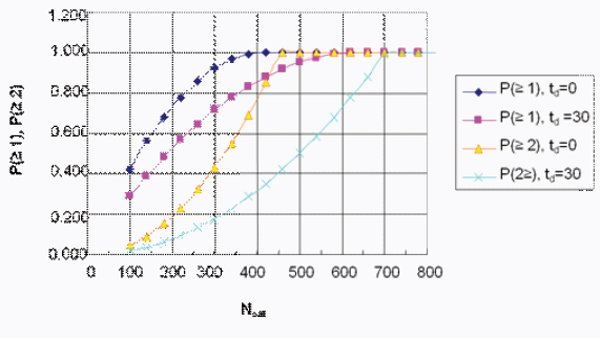
FIGURE 2-19 Probability as a function of the number of satellites in the constellation for a liquid-propellant ICBM launched from Iran and notional 5.0 km/sec interceptors.
Potential Scenarios for Intercepting Hostile Missiles in the Boost Phase of Flight
One can envision scenarios in which intercepting hostile missiles in their boost phase of flight appears practical. Here are three such scenarios; however, it is important to note that none of the scenarios involves developing new systems such as ABL or KEI. Rather, each uses existing systems.
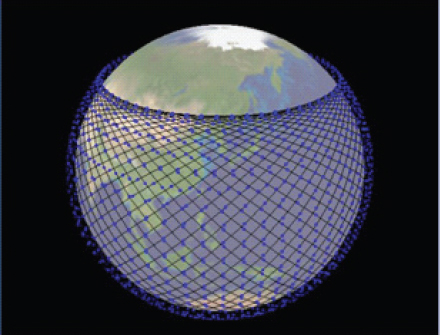
FIGURE 2-20 The approximately 1,600 satellites that must be maintained in orbit for a space-based boost-phase system to counter the solid rocket technology being pursued by Iran. ©2011 Google, Map Data ©2011 Tele Atlas.
Countering Early Deployment of Chemical or Biological Submunitions in Theater Conflicts
Chemical or biological submunitions deployed immediately after boost phase are a low-technology threat that could saturate terminal and exoatmospheric defenses at shorter missile ranges. Because such weapons are area dispersed and do not require precise delivery, it is not far fetched to contemplate that if each is encapsulated in an ablative material such as silicone rubber to survive reentry, they could be deployed immediately after boost phase. While not a game changer on the battlefield, such weapons require the donning of protective gear, which would impede and disrupt combat operations. Such weapons are far more disruptive to civilian targets. The latter threat has been studied and found practicable when the short-range reentry heating is modest and the means for thermal protection does not need to be sophisticated. In such a case, the submunitions cannot carry and do not require individual guidance and control systems but simply are ejected at low dispersal velocity.
Only boost-phase intercept, prelaunch attack, or midcourse sterilization of the threat volume would be able to counter this type of threat. It is one scenario in which intercepting a hostile missile in its boost phase of flight might be efficacious. Specifically, carried by multimission aircraft as part of their ordnance load and having as their primary mission the destruction of a missile launch capability or other ground target, such airborne boost-phase interceptors could, once air superiority had been established, engage any weapons that were able to launch in an adversary’s airspace. Alternatively, some form of volume kill—sweeping or sterilizing the threat volume after the payload has been deployed—might be used. The sooner this could be done after submunition dispersal, the smaller the volume that would have to be swept but the more vulnerable the sweeper platform would be. Unfortunately, there is no effective volume kill capability other than the detonation of a nuclear weapon.
Countering Ship-Based Theater Ballistic Missiles Launched with Early Deployed Submunitions Against CONUS, Deployed Forces, U.S. Allies, Partners, or Host Nations
Some observers consider the possibility of attacks by short-range ballistic missiles launched from ships near U.S. (or allied) shores to be a very serious potential threat. Transfers of older liquid-fueled theater ballistic missiles (TBMs) to nonstate actors have already been reported. Ship-launched TBMs with chemical or biological submunition payloads from rogue or nonstate actors aimed at large U.S. coastal population centers would have no immediate return address. While the prospect of a nonstate actor getting nuclear material (at least enough for a dirty bomb) cannot be excluded, a simpler chemical or biological attack could do substantial damage and might be an attractive option for such an actor.
Because the launch point for such a threat would, by definition, be relatively
close to U.S. territory, boost-phase intercept could be practical. Existing SM-2 Block IV air defense interceptors launched from within 50 km of the ship launching the threat could engage such shorter range threats during boost phase, within the atmosphere. In addition, CONUS-based tactical aircraft carrying weapons if developed for theater boost-phase intercept could be scrambled to fly CAP either over any suspicious ship that evaded detection before reaching a threatening range or until an Aegis ship arrived. For example, a fighter aircraft interceptor platform equipped with an appropriate acquisition sensor and perhaps a modified AMRAAM could be first on the scene for that mission if no Aegis ship was within 50 km.
These are not likely to be large-scale threats that warrant the development of a special system to counter them, and modified existing assets could probably play that defensive role at least for the coastal threat. Specifically, Aegis ships with some SM-2 Block IV interceptors that can shadow suspect ships closely enough to engage any launch in its boost phase, followed by a counterbattery strike on the ship itself, could be deployed on both coasts.
Countering Long-Range Missiles Launched from North Korea Toward Hawaii or the Mid-Pacific
There is a case in which the relative geographical location of a threat country and its potential target would allow boost-phase interceptors to be stationed routinely in positions from which boost-phase intercept would be feasible. This case is the long-range threat trajectory from North Korea to Hawaii or other mid-Pacific islands.22 Here, three conditions would need to be met for such a boost-phase intercept to occur: (1) the threat would be coming toward the interceptor launch platform (an Aegis ship in international waters, say) so the geometry is at a favorable angle; (2) the boost-phase timelines would be long enough to allow a boost-phase engagement in that unique geometry; and (3) an SM-3 sized interceptor would have sufficient reach within a rational timeline, it would be externally cued, and its KV would have the necessary additional agility.
It has been suggested by some that a capability exists for the essentially instantaneous detection of a missile launch from its silo or launch pad, which would allow earlier commit of a boost-phase interceptor and thereby somewhat extend its range. Of course, very early detection would buy many seconds more of additional fly-out time for interceptors than would waiting for sensor data (from a space-based infrared system (SBIRS)). Here, the idea would be to fire an interceptor toward a nominal point in the fly-out corridor as soon as a launch is detected and to update the interceptor during its powered flight, when better data
_____________
22The “long-range” condition reflects that some potentially significant targets, like U.S. bases on Guam or the Japanese homeland, are so close to North Korea that a ballistic missile aimed at them would have too short a burn time (and too low a burnout altitude) for a boost-phase intercept to be feasible from an Aegis inteceptor on board a ship in the Sea of Japan.
are available, diverting it to a better-predicted intercept point—with an intervening coast, if needed—before igniting a third stage. Boost-phase engagement firing doctrine calls for the interceptor to be used this way to divert during its powered flight in order to reduce the divert velocity and acceleration requirement for the kill vehicle to deal with; however, it does not commit interceptors until the threat’s heading can be estimated.23
Testing of Boost-Phase Defense Systems: Results to Date and Outlook
The committee was tasked to assess the past and planned test programs’ value in demonstrating feasibility and the cost-effective utility of the KEI and ABL programs. While the cancellation of KEI and the realignment of the ABL program to an R&D test bed (with which decisions the committee concurs) have made this assessment somewhat moot, the committee has observations about both.
Kinetic Energy Interceptor
The KEI program was terminated after cost and schedule problems delayed flight testing of the vehicle. Both stages of the booster had been ground tested and were deemed ready for flight test, and simulations using some actual tactical warning and attack assessment (TWAA) elements were conducted with the battle management architecture.
That said, the committee believes the foregoing analysis illustrates that no matter how successful tests might one day have been, the system would have had negligible utility as a boost-phase system because it cannot be based close enough to adversaries’ fly-out corridors to engage either long- or short-range missiles without being vulnerable to attack. Neither KEI nor any version of SM-3 that will fit on existing launchers has enough reach to have military utility as a boost-phase defense.
The committee agrees with the decision to cancel the KEI program as such, but the booster rocket motors could, with some modifications, be used as part of a more effective Ground-Based Missile Defense (GMD) system. The committee returns to this subject—a recommended evolution of the GMD—in Chapter 5 of this report.
Airborne Laser
Several tests have been conducted with mixed results for one reason or another. None of the problems have been fundamental to successful operation of
_____________
23The committee also shows that it is counterproductive to commit an intercept earlier than the timelines shown in Figure 2-3 even if the launch can be detected immediately (see classified annex, Appendix H).
the laser or its beam conditioning and control. Several target missiles have been destroyed, but all the tests have been at ranges too short to have any military utility for boost-phase defense. The limitations of the ABL are due to the need to sight at low elevation angles through the atmosphere, which fundamentally limits the standoff range for boost-phase engagements. No amount of future testing is likely to change that limitation.
Accordingly, the committee concurs with the DOT&E report, which concludes that the ABL has no operational utility for missile defense for a variety of reasons, not the least of which is the illogic of placing such an expensive asset in harm’s way because of that range limitation.24 The committee found no reason to believe that ABL could ever be an effective boost-phase defense system, and it believes that the reversion of the ABL to a research and development test bed was a sound decision.
There are logical applications that were identified by the Defense Science Board in an unclassified report that do not entail such short reaction times, going in harm’s way, endurance on station, or atmospheric problems at low elevation angles.25 Specifically, the single existing ABL could serve as an emergency antisatellite (ASAT) device. The aircraft could on its own timeline be positioned to deposit energy on a spacecraft for dwell times limited only by its entire operating time at very high angles of elevation without going anywhere near an adversary’s air defenses. Advanced high-powered solid-state or hybrid lasers could be tested on board as well.
FINDINGS
Terrestrial-Based Boost-Phase Defense
Major Finding 1: While technically possible in principle, boost-phase missile defense—whether kinetic or directed energy, and whether based on land, sea, air, or in space—is not practical or feasible for any of the missions that the committee was asked to consider. This is due to the impracticalities associated with space-based boost-phase missile defense (addressed in Major Finding 2), along with geographical limits on where terrestrial (nonspace) interceptors would have to be placed and the timeline within which such interceptors must function in order to defend the intended targets.
• Intercept must take place not just before burnout of the threat booster but also before it reaches a velocity that can threaten any area to be protected.
_____________
24DOD Office of Testing and Evaluation. 2010. “Airborne Laser (ABL) Assessment of Operational Effectiveness, Suitability, and Survivability,” January.
25Defense Science Board. 2001. Defense Science Board Task Force on High Energy Laser Weapon Applications. Office of Under Secretary of Defense for Acquisition, Technology, and Logistics, Washington, D.C., June.
Because of the short burn times of even long-range ballistic missile boosters, the interceptor launch platform cannot for its own survivability be so close to the territory of an adversary as to be vulnerable to the adversary’s perimeter defenses, but it must be close enough to the boost trajectory so that the interceptor can reach the threat missile before it reaches its desired velocity.
• Surface-based boost-phase interceptors are not feasible against a large country like Iran for missiles of any kind unless the interceptor platforms are based in the southern Caspian Sea. While it has been suggested that unmanned stealthy aircraft could loiter inside or close to the borders of an adversary, the committee does not believe it to be a feasible approach against a country with an effective air defense like Russian S-300 SAMs, in the face of which stealth aircraft will have a limited time of invulnerability as they maintain station in an environment with a high-density air defense sensor.
Range Limits
In practice, the operational limits on both kinetic and laser interceptor ranges necessitate that boost-phase defense platforms be located near likely launch sites (or, more precisely, near possible intercept points). Locations that meet the requirements are available only in certain limited circumstances—a relatively small threat nation and good access to areas near it over international waters or friendly territory and outside the range of its air defenses.
For kinetic interceptors, range is limited by the short duration of powered flight for ballistic missiles—approximately 180-250 sec for ICBMs (although some liquid-fueled types may have longer boost times) and approximately 60-180 sec for short-, medium-, and intermediate-range ballistic missiles.
Boost-phase defense of allies or deployed forces against shorter than intercontinental range attacks requires even closer stationing than for longer range threats, because shorter boost times and lower altitudes at burnout—which are the determinants of the windows for boost-phase intercept and of the proximity requirement for both kinetic and laser intercept—are even more demanding. Only in highly favorable geographic situations, e.g., trajectories from North Korea to Hawaii and some other Pacific Ocean targets, is it likely that boost-phase interceptor platforms could be located so as to overcome the time, distance, and altitude constraints.
Despite their essentially unlimited speed of “flight,” the use of lasers as the kill mechanism does not avoid the requirement for relatively close-in stationing of the interceptor platform. Lasers operate at the speed of light, but they are range limited because laser power deteriorates with distance from the target. Moreover, although the laser beam reaches the target at the speed of light, it must dwell on the target for several seconds to deposit sufficient energy on the booster to destroy it. The altitude of the target at thrust termination and of the platform for the interceptor also contribute to loss of power on the target, limiting effective
ABL range. The dwell time relative to the short duration of an engagement also limits the raid handling capability of any laser ballistic missile defense system.
The net effect of these time, altitude, and range constraints is that both kinetic and laser boost-phase interceptors must be ready to engage from within a few hundred kilometers of the intercept point. As a practical matter, the interceptor platforms must be ready to engage on or over international waters or friendly land areas. (It is sometimes claimed that stealth UAVs armed with boost-phase interceptors could operate in an adversary’s air space. However stealth is extremely difficult to maintain for platforms loitering for long periods in airspace under surveillance by a reasonably capable air defense.)
Decision Time and Command and Control
Missile defense operates within the established military chain of command and employs systems of control and authorization that are consistent with standard operational practices that have withstood the test of time and suit real-world considerations.
In standard U.S. practice, weapons release authority is reserved for the higher command echelons, indeed ultimately for the President as commander in chief of the armed forces. Reliable and redundant communication links tie the release authority to the personnel in immediate control of the weapons system in question. However, it is equally a principle of the command and control system that requirements for higher-level authorization should not be so inflexible as to delay action to the point of ineffectiveness. Rules of engagement—which can change as threat conditions change—are guidelines for action, including when time or other considerations make seeking higher authority infeasible.
The special circumstances of missile defense—the potential of a missile attack to do massive damage, the ramifications of mistakenly destroying a foreign nation’s space launch vehicle (or even a routine developmental test missile), the possibility of creating space debris (or debris or even weapons falling to Earth), the compressed timelines and heavy reliance on sensor data—make it difficult to strike the appropriate balance between higher level—ultimately Presidential—control and sufficiently rapid response.
These problems arise for any missile defense. The flight time for an ICBM attacking the United States from Iran would be only about 40 minutes, and all other flight times can be shorter. The time needed to detect and characterize a threatening launch—probably on the order of 1 min—and the time needed to conduct the intercept after weapon release—on the order of 15-17 min for midcourse intercept—leave a window of only a few minutes for requesting release authority, for the decision maker to consider and make the decision, and for that decision to be communicated to personnel who control the interceptor system.
The problem is challenging enough for midcourse intercept, where the window for engagement would be a few tens of minutes. Even more daunting would
be the authorization of a boost-phase intercept, for which there would be virtually no time because the interceptor would have to begin the engagement within seconds of the sensors reporting that a hostile launch had occurred.
The short boost period not only imposes limits (far more significant for kinetic than for laser-kill systems) on the time available for the intercept itself, it also means—for either laser or kinetic kill—that there be very rapid detection of the launch; its classification as threatening; tracking; decision and release authority to engage; and execution of release with all of these in addition to whatever time is needed for the engagement itself. Accomplishing this in the time available is a formidable operational challenge.
The short time for intercept raises an important policy question. To allow boost-phase interceptors to be fired within a few tens of seconds of detection of the launch of the attacking missiles, authority to engage would have to be delegated to the military personnel with immediate control of the system. Indeed, in practice, the “decision” to intercept would need to be made largely by a computer program, with human input essentially limited to confirming that the system appears to be functioning properly. Accordingly, civilian and higher level military authority would have to be exercised by determining the rules of engagement that were embodied in the computer program rather than in real time during an actual attack.
Other Issues
A significant technical limitation of boost-phase intercept, in addition to those presented by the short powered flight of the target, arises from the fact that ballistic missiles are accelerating nonuniformly during powered flight, not to mention almost discontinuously at staging events. This further complicates predicting the target’s future location, which for kinetic-kill intercepts increases the divert requirements for the kinetic-kill vehicle. Also, the target is accelerating rapidly, which means that the interceptor must have a comparable acceleration capability. As a result, kinetic-kill vehicles designed for midcourse intercepts will have limited boost phase intercept capability even if one assumes they are stationed within range of the intercept point. These requirements for boost-phase kinetic kill can be met technically, but they add to the weight and complexity of boost-phase intercept systems.
A further technical and operational issue for boost-phase intercepts is that even a successful intercept has the “shortfall” problem—that is, the potential not just for fragments of engines, fuel tanks, and the like but also for an intact and armed nuclear weapon to fall on friendly or neutral territory. Moreover, it is a misconception that a boost-phase intercept could cause threat missile debris to fall on the country of origin. In short, it is physically impossible for this to happen unless the interceptor is based in the country of origin and is close enough to the threat launch point to intercept the threat in the atmosphere.
Indeed, by the time of intercept, which would take place relatively late in powered flight and well above the atmosphere, the reentry vehicle (RV) would already have been given sufficient velocity to continue on a trajectory that could extend into the original target area, or at least into friendly or neutral territory, and produce a nuclear detonation on impact. In principle, a kinetic-kill boost-phase interceptor could be aimed so as to impact the RV containing the warhead (as contrasted to the booster itself), but ensuring such impact would be challenging, because of uncertainties about the position of the RV relative to the hot rocket exhaust, which is guiding the interceptor. A laser kill mechanism, even if properly aimed, would probably not be powerful enough to destroy a warhead carried on an RV hardened to survive reentry. It might, however, be possible to count on midcourse defense to deal with RVs that “escape” from a boost-phase intercept. It can therefore also be concluded that none of these measures to mitigate “shortfall” are likely to be effective, and that the consequences of a nuclear detonation on land “caused” by a U.S. intercept would be so severe that a boost-phase system must constrain intercepts to windows that minimize the risk of an RV falling on land. Such a constraint would, however, add another significant limitation to the already extremely tight window for intercept.
Finally, boost-phase intercepts are not immune from countermeasures, including hardening to reduce the booster’s vulnerability to lasers, spoofing precursor launches, and the like. Iran has conducted tests in which several missiles of various types were launched nearly simultaneously. A nation could seek to defeat a boost-phase defense by launching several decoy boosters at the same time as the actual missile in the hope of confusing, or even overwhelming, the defense’s sensors and data processors. Even more sophisticated countermeasures can be postulated—for example, fractionated upper stages—though typically they come at a price to the offense in terms of complexity and reduction in volume available for the weapons payload.26
Overall Evaluation
As a practical matter, however, these other potential disadvantages would be dwarfed by the fact that both kinetic and laser interceptors would have to be on platforms relatively close to the targets. Even leaving aside how such proximity would expose the interceptor platforms to attack, this range-determined constraint makes boost-phase intercept operationally infeasible, because, except in a few cases, it would not be realistic to count on a boost-phase intercept platform being close enough to effect intercept.
• In particular, Iran is too large geographically (and its northern neighbors
_____________
26Additional discussion on decoys and countermeasures is provided in the classified annex (Appendix J).
too unlikely to consent to U.S. boost-phase intercept overflights or basing) to make boost-phase operationally feasible, even against liquid-propellant ICBMs.
• By contrast to Iran, the small size of North Korea and its long coastlines mean that boost-phase intercept for ICBMs is not ruled out by geography, as long as North Korea sticks to liquid-propellant engines, and a large enough interceptor such as KEI could be based at sea, as explained below.
• In general, boost-phase intercept systems are more feasible the longer the boost time of the target missile. Therefore, they tend to be more feasible against liquid-propellant missiles than solid-propellant missiles, owing to the longer boost times associated with the former. However, it would be imprudent to justify boost-phase intercept development based on its potential against liquid-propellant missiles when solid-propellant missiles are an obvious countermeasure; such a system could become obsolete as soon as it is deployed. In fact, the deployment of a boost-phase intercept system would likely stimulate the development of solid-propellant systems if they were not already being pursued for other reasons (e.g., solid-propellant missiles are more suitable for mobile deployment and hence can survive better against air attack). For example, Iran already has tested a two-stage solid-propellant medium-range ballistic missile (MRBM). Boost-phase intercept deployment against liquid-propellant missiles would be justified only if a hostile country does not, or cannot, deploy solid-propellant ICBM technology, as was the case for the former Soviet Union for almost 40 years. So far, there is no sign that North Korea is working on solid-propellant rockets for longer range missiles, but it could shift toward solid propellant, possibly with assistance from Iran, with which it has significant cooperation. The question becomes, Should the United States invest in a boost-phase system with some capability against liquid-fuel North Korean ICBMs if that country might shift to solid-fuel rockets before or soon after the system becomes operational?
• There may be specialized cases in which boost-phase defense is feasible because either the threat must come toward the platforms or the platforms can be placed close enough to the threat and in an adequately benign environment. For example, a boost-phase intercept might be workable if the threat is North Korean medium- or long-range missiles heading toward U.S. bases in the western Pacific and therefore flying toward the Sea of Japan, on or over which boost-phase intercept platforms could be stationed. In this situation, and comparable situations elsewhere, the platform proximity problem is manageable, because the threat is coming toward the interceptor.
Space-Based Boost-Phase Defense
Major Finding 2: While space basing for boost-phase defense would in principle solve the problems of geographical limits that make surface-based boost-phase intercept impractical, the size and cost of such a constellation system is extremely
high and very sensitive to the timeline in which interceptors must be launched. As a result it is susceptible to countermeasures such as salvo launches that either delay and reduce its coverage or squander space-based intercepts.
• In principle, a constellation of satellites equipped with boost-phase interceptors could be configured so as always to be geographically in range for an intercept. The number of satellites required depends, in part, on the burn time and altitude of the threat missiles. Shorter powered flights of solid-fueled threat missiles require many more satellites for coverage. Shorter range missiles with their shorter burn times and lower burnout altitudes cannot be engaged by space-based boost-phase intercepts.
• The total life-cycle cost of placing and sustaining the constellation in orbit is at least an order of magnitude greater than that of any other alternative and impractical for that reason alone.
Overall Evaluation
Space-basing for boost-phase intercept would, in theory, solve the problems of proximity that make surface- and air-based boost-phase interceptors generally impractical. In principle, a constellation of satellites equipped with boost-phase interceptors could be configured so as always to be geographically in range for an intercept. The number of satellites required would depend in part on what threats are to be defended against. Shorter powered flight times for the threat missiles would require more satellites for coverage.
A space-based system would have to overcome objections (and, arguably, legal obstacles) to “weapons in space.” More important, a space-based system would be vulnerable to the sort of primitive ASAT device that a country capable of deploying an ICBM would probably be able to develop.
The most powerful objection to a space-based system, however, is the total acquisition cost (both initial and replacement satellite costs plus launch costs) for the large number of satellites needed for continuous coverage of potential threat launch locations because of the relative motion of satellites in orbit to Earth below (see Appendix J in the classified annex). Some 700 satellites would be required for defense against liquid-fueled ICBMs and some IRBMs, with some residual capability against solid-fueled ICBMs. For confident defense against solid-fuel ICBMs, as many as 1,600 to 2,000 satellites would be needed. The total life-cycle cost of developing, building, launching into orbit, and maintaining in orbit, even an austere and limited-capability network of 650 satellites, for example, would be approximately $300 billion (in FY 2010 dollars). The cost for greater capability would be correspondingly greater. From an annual acquisition cost perspective, these relatively high costs over the time frame estimated to provide operational space-basing for boost-phase interceptors would probably prove unaffordable.
Airborne-based interceptors (ABIs) have been proposed for boost-phase defense and possibly for terminal defense. All near-term systems on which the committee was briefed have very limited boost-phase capability (intercept ranges on the order of 50 km). The limited ranges of which a system would be capable do not allow boost-phase intercepts from outside the territory of even a small country such as North Korea. Such a system would be viable only if the aircraft could fly CAP for extended periods of time over enemy territory after air supremacy had been achieved.












































